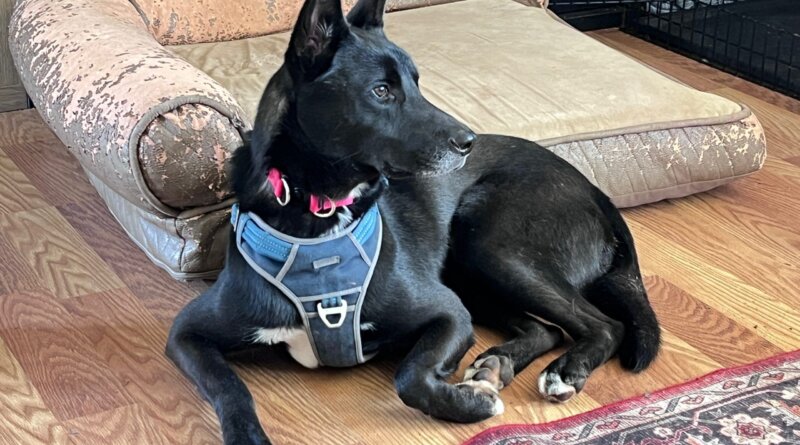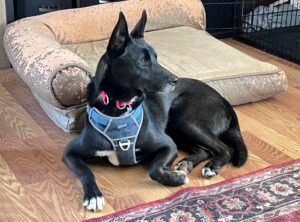Give Them Time! – Whole Dog Journal
Today I am dog-sitting Chief, a 1-year-old German Shepherd-mix from my local shelter – just for the day. He’s actually being fostered by my favorite person at the shelter, my friend Lynee.
Chief was brought to the shelter over a year ago as a young pup. As yet ANOTHER uneducated, no-manners, anxious, all-black dog in a shelter full of them, he has lingered and lingered. He got adopted once but was brought back because the family’s old dog didn’t like him. (Few old dogs like wild young dogs with no social skills, especially within days of having the wild youngster arrive in their homes.)
Recently, Chief got adopted again – but he was so overwhelmed in the new family’s home that he hid behind the couch and wouldn’t come out. When the family tried to insist, reaching behind the couch with a leash, he growled at them. Since the family brought him home on a Saturday, and this happened on a Sunday, when they called the shelter in an apparent panic that the dog was vicious, the message on the shelter’s answering machine said, “In an animal-related emergency, call the (local) police department…” So they did!
Fortunately, the police contacted the animal control officer who was on call, and he went to the family’s house to pick up Chief. (Literally. He picked up the 60-pound dog and carried him to the animal control truck. He reported that Chief was petrified.)
Worried that two bad experiences in homes reduced the odds that he would get a third chance at a family, Lynee took Chief home last weekend. She reported that he had to be pulled out of her car, but he followed her into and then around the inside of her home like he was glued to her side. At first, he was too afraid to go outside to go to the bathroom, but she encouraged him, and, partly lifting him by his harness to get him out the door, pulled him outdoors. Once there, he went potty, and then rushed back into the house.
Lynee stayed home with Chief for three days. She said that every day he made progress. After that first time being lifted/pushed outdoors, he went outside to potty with just encouragement. He wouldn’t eat food or treats the first day, ate only canned food the second day, but ate kibble with just a little canned food mixed in on day three. He wouldn’t interact with her other dogs on day one, but by day three was playing chase games outside.
On day four, Lynee and her husband lifted Chief into their car and took him and their oldest dog for a short field trip to our local wildlife area. They let him explore on a long line and he waded into the river and enjoyed sniffing all the interesting smells. He got into the car on his own power for the trip home.
Both of the families who adopted Chief before were told that he had been brought into the shelter as a puppy, and didn’t know anything else. That he was undersocialized and essentially didn’t know anything about the world outside nor any dogs other than dogs he was kenneled with in the shelter. And yet neither family gave him the time and space to acclimate and learn about the world outside a shelter.
Lynee had to go to work today, and she didn’t want to leave Chief home alone all day; nor did she want to bring him back to the shelter. So she asked if I could do a little daycare duty. Of course! This will give Chief even more experience in yet another environment – but a safe, non-demanding space, where no one will have any expectations of him and he can observe everything in the environment without pressure.
I met Chief a month or so ago at the shelter, when Lynee had him in an exercise yard. My impression of him then was of a hyper but nice young dog – just what you would expect of a dog who had grown up in a loud, busy shelter. So far, walking around my property and laying in my office as I write this, he’s calm and quietly observing everything. He’s taking treats from me, and hasn’t been too afraid to enter and exit the outbuilding where I work. And this transformation is after just three days in Lynee’s home.
When you bring a dog home from a rescue or shelter – or anywhere, actually! – give them space and time! Be friendly and encouraging, but don’t loom or fuss over them. Try not to make demands on them at first, but reinforce every behavior you like to see. Set up the environment (with pens or gates) so they can’t get into places or getting into things you don’t want them near, so you don’t have to scare them by rushing them out of those spaces. Keep in mind that they might not know anything about human cars, homes, or other animals, and they may react with fear, and yes, even growling. Remember, a growl means, “I need some space!” It’s meant as a distance-creating message. It doesn’t mean they don’t like you or plan to attack you!
There has been a “3-3-3” meme going around the shelter and rescue community for a while that says something like, “The first three days with your newly adopted dog should be used to adjust, the next three weeks for training and bonding, and the next three months for continued training and socialization.” Our contributing editor Pat Miller hates this meme and wrote an article with her preferred version of the good intentions behind the meme: Give your new dog all the space and time they need to decompress and get to know you. Sometimes this happens quickly – even immediately. But take it from Chief: Sometimes you just need a little more time.





